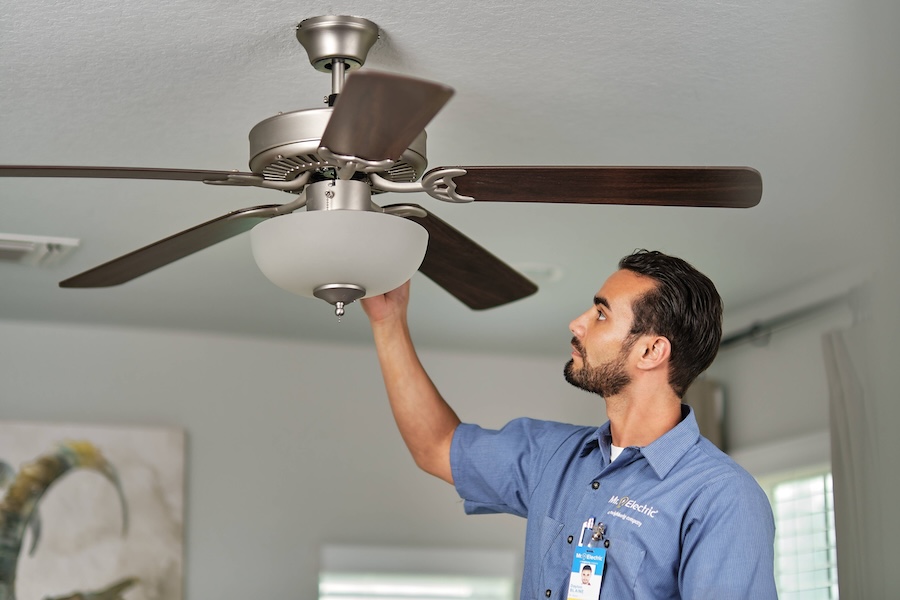Call this Friday to Get $35 OFF.
Hire Local Trusted Electricians Now
Call This Friday to Get$35 OFFCall this Friday to Get $35 OFF.
Hire Local Trusted Electricians Now
Call This Friday to Get$35 OFFCeiling fans have always had a certain charm. They’re practical, stylish, and energy-efficient all at once. A good fan can transform a room by bringing not only a gentle breeze but also a sense of balance to the space. Still, many homeowners underestimate one of the most important aspects of selecting a ceiling fan: choosing the right size for the room.

A ceiling fan that’s too small won’t circulate air effectively; one that’s too large can overwhelm the space and waste energy. Finding the perfect fit is about more than guesswork; it’s about understanding proportions, airflow, and the role of installation.
In this brief article brought to you by Mr. Electric, we break down the basics on sizing your ceiling fan installation. If you'd rather consult a certified electrician on the matter, then call Mr. Electric to hire a local professional today.
Everything in your home, from the lights and kitchen appliances to your HVAC system, depends on electricity for power. When electrical problems arise,…
Read MoreA circuit breaker protects you and your family from electrical hazards. When it begins to malfunction, the risks can quickly snowball from a…
Read MoreCeiling fans add style and improve energy efficiency, but the process of installing or replacing a ceiling fan isn't always as simple as…
Read MoreYour home's electrical system is something you rely on every day, but it doesn’t always make it obvious when there’s a problem. Flickering…
Read MoreCeiling fans offer aesthetic appeal and some even come with integrated lighting, but their primary job is to move air efficiently and evenly - and a fan’s size is directly related to the area it can cool or circulate air through. If your fan is undersized, you’ll notice hot spots where air feels stagnant. If it’s oversized, then you might find yourself with a wind tunnel effect that makes the room uncomfortable.
When it comes to sizing, the blade span (measured from the tip of one blade to the tip of the opposite blade) is the key factor. Manufacturers design fans to fit certain room sizes, and you have to get this right if you want the fan to work with your space rather than against it.
For compact areas like bathrooms, laundry rooms, or even walk-in closets, fans with a blade span of 29 to 36 inches are typically ideal. These smaller fans provide circulation without overwhelming the limited square footage.
Imagine trying to squeeze a massive 60-inch fan into a tiny bathroom. It wouldn’t just look awkward; it would also disrupt airflow in ways that cause serious discomfort. For rooms that are under 75 square feet, stick with the smaller options.
Living rooms, standard bedrooms, and kitchens with spaces ranging from 76 to 150 square feet usually fall into the "medium" category. For these rooms, you’ll want a ceiling fan with a blade span of 42 to 48 inches.
This size strikes the right balance of being large enough to effectively circulate air without dominating the space. In fact, medium-sized fans are among the most popular choices because they work for the most common room layouts.
If you’re working with a larger bedroom, a family room, or an open-concept living area, then you’ll need more airflow power. Rooms measuring 150 to 225 square feet generally call for fans with blade spans between 50 and 54 inches.
For oversized living areas or spaces bigger than 225 square feet, you'll want to look at blade spans 56 inches or bigger. In some open layouts, one fan still may not be enough. It’s common to install two or more fans in larger areas for balanced circulation.
The square footage is not the only thing to consider. The ceiling's height also plays a role in choosing the right ceiling fan installation. For rooms with standard 8-foot ceilings, a low-profile or "hugger fan" is often the best choice. If your ceilings are taller, then you’ll probably need a downrod to position the fan at the optimal height
Selecting the right ceiling fan size for your room is part science, part style, and part practicality. Focus on blade span, ceiling height, and room dimensions to make the most of your new unit.
But even the perfect fan won’t do its job if it’s installed improperly or supported by outdated wiring. That's where a certified electrician comes in. They'll not only handle the installation but make sure the underlying electrical system is up to the task.
Whether you need a ceiling fan installed or replaced, or are looking for emergency electrical repair, the local pros at Mr. Electric are here to help. Call or message us at any time of the day to get in touch.
Smoke detectors quite literally save lives by giving inhabitants vital seconds to escape, but these safety devices are neither indestructible nor forever. Responsible…
Read MoreSmart doorbells have moved from high-tech novelty to an everyday essential. They help you monitor deliveries, deter porch pirates, and keep an eye…
Read MoreElectric vehicles have taken the world by storm, and public charging stations are popping up across the nation – but nothing beats an…
Read MoreFor many business owners, few words spark more anxiety than “rewiring.” It sounds expensive, messy, and disruptive. And while it’s true that upgrading…
Read More